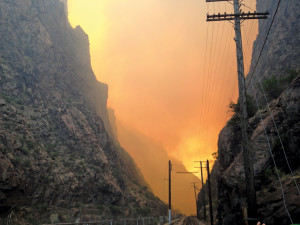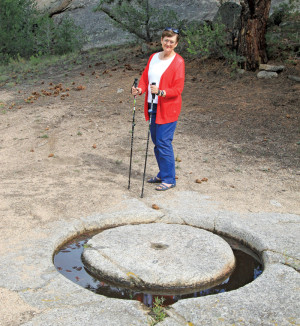By John Mattingly
This is the first in a series of articles about “fluid curiosities” of Colorado water laws as they may apply to the San Luis Valley, where water users and attorneys are in the process of forming subdistricts to achieve sustainability in use of the Valley’s rechargeable aquifers. This series comes, of course, with a wide disclaimer that these are my personal opinions, not those of Colorado Central, any state agency, or other individual.
A person with remarkable physical endowments creates an eye-turning point of diversion, as do tricksters who want to divert the attention of authority. Some criminals use a stunning diversion to draw away the attention of law enforcement, and American football plays try to structure diversions that result in the misdirection of defenses. Magicians use sleight of hand to conceal a point of diversion that confuses our senses.
In Colorado water law, however, a point of diversion is the point where the holder of a decreed water right removes water from a natural stream or water body through a controlling structure. Diversion is a requirement of appropriation – that is, a water right will not become absolute until wet water has been physically diverted and put to a qualifying beneficial use. The only exception is that certain state agencies can appropriate water in a stream without a structure: in-stream flow rights and recreation rights. Otherwise, an appropriator’s diversion structure must be a physical structure and be efficient according to community standards.
There is, however, a fluid curiosity when we look at the point of diversion for a groundwater right. To understand this curiosity, I need to take a bit of a diversion to explain some basic points about a point of diversion. Please bear with me ….
1. Interestingly, only the word diversion is included in the Colorado Revised Statutes (CRS) definitions in Title 37, Water and Irrigation. The term point of diversion is not strictly defined, apparently because it seems obvious enough that the point of diversion is the exact point in topology at which the water is removed from the natural water course or water body.
2. With a surface water appropriation, the point of diversion is usually obvious by the diverting structure: a concrete barrier, a pipe, a weir box or even a natural formation in the stream bed that has received some enhancements. In large stream diversions, there is usually a way to micro-regulate the gross amount diverted by use of return-flow valving systems.
When hiking around the streams and rivers of the West, you will see remnants of old diversion structures that show extraordinary determination of irrigators. In some canyons there are trestles and open-faced culverts hanging off rock walls. Some old irrigators, or mutual ditch companies, realized that they could go up the watershed that fed their water right and, using only mules and Fresnos, divert water at the Divide such that water that was headed down another irrigator’s basin was diverted to add to their own yield. If caught in the act of doing this, the perpetrators risked being buried in the wild.
There is no question that the inventiveness, hard work and home-grown engineering displayed by surface water diversions in the West is remarkable by any standard, but it is perhaps most appreciated by those of us who made irrigated farming our lifetime profession. Water is essential to life and economic survival. When water is needed to save a crop, an irrigator will be inspired to heroic measures of acquisition, including occasional larceny.
3. Not only are points of diversion on rivers and streams in the West minor engineering marvels, they point to some important legal principals in water law. A point of diversion represents the point where an appropriator’s water right is measured, and the point that is used in considerations of injury or impact on other appropriators. This seems obvious enough. Water seldom disobeys the law of gravity, so it does not require complex algorithms to create a water distribution regime based on gravity and time.
Though painfully obvious, it must be noted here that the law of gravity makes it unlikely that a downstream appropriator can injure an upstream appropriator, because if the stream has flowed past an upstream point of diversion and was not diverted, it becomes open to diversion by a downstream appropriator. I did not say it is impossible for a downstreamer to injure an upstreamer, because use of the word impossible in the context of water rights is always hazardous, given the extraordinary ingenuity of a desperate irrigator. But for most intents and purposes, injury claims are usually brought by a downstream appropriator claiming that an upstream appropriator is taking too much water, or is using some sleight of hand to magically divert more than decreed, thus depriving (injuring) the downstream appropriator.
4. In most cases, an irrigation water right is applied to beneficial use close to the point of diversion, and thus the point of measurement and point of beneficial use are the same. This means that an appropriator cannot take water out of a stream, run it several miles in an open ditch, and measure the water flow at a point distant from the stream. Reason: there are carriage losses in the open ditch, and those losses must be borne by the appropriator, not the stream (unless the appropriator originally decreed a point of diversion at some distance from the water body). This is a longstanding principle and is judiciously honored in the administration of water rights.
5. Finally, once decreed, a point of diversion cannot be changed without going to water court to allow other appropriators on the stream an opportunity to assess whether the change in point of diversion will result in injury to their existing rights. Generally, moving a point of diversion upstream causes a larger disruption to the priority regime than moving it downstream, but any change in a point of diversion today is likely to cause prompt opposition from other appropriators.
I now apologize for going all Wikipedia on the reader, who, with any luck, is still reading. The point here is to get to that aforementioned fluid curiosity about a point of diversion with respect to groundwater diversions. The stated point of diversion for a groundwater right in Colorado is the topological point where the water discharges at the wellhead. But this is not the point where the water is removed from the natural water body – in this case, the aquifer. The actual point of diversion for a groundwater right is, by legal definition, somewhere beneath the surface. In some cases, it is the suction point of the column pipe within the well casing. Some might argue that it is the point in the casing where perforations begin, but this is not the point where the water is actually removed. The point of removal is the point where the suction pipe to the pump pulls in the water, usually a hundred or more feet below the surface.
This may sound elementary at first, but it becomes of paramount importance if we consider possible injury relations between groundwater rights and surface rights. Given the many basic, time-honored and fully litigated principles of Colorado water law regarding points of diversion, a groundwater right must be considered to have a point of diversion below the ground, not at ground level.
Therefore, all groundwater modeling presently created to assess and determine potential injury as between ground and surface appropriators should, by reason and law, apply the subterranean point of diversion for groundwater rights in determining potential injury relationships. This, however, may not be the case if the groundwater modeling used for the San Luis Valley assumes the point of diversion for groundwater rights as being at the topological surface. Because a prior ruling has declared the model to be, appropriately, a BAT (Best Available Technology) and therefore determining as to injury relations between ground and surface water appropriators, errors of consequence may be inevitable.
Recall that it is unlikely that an upstream appropriator can claim injury from a downstream appropriator, not only because a water right is use-based, but because water obeys the law of gravity. But then again, the civil law and BATs don’t always obey the laws of nature.



